|
Have a safe day!
Thursday, Aug. 15
2:30 p.m.
Theoretical Physics Seminar - Curia II
Speaker: Chia-Cheng Chang, University of Illinois at Chicago and Fermilab
Title: Local D0 Hadronic Matrix Elements from 2+1 Lattice QCD
3:30 p.m.
DIRECTOR'S COFFEE BREAK - 2nd Flr X-Over
4 p.m.
Accelerator Physics and Technology Seminar (NOTE DATE) - One West
Speaker: Daniele Pelliccia, Monash University
Title: Hard X-Ray Diffraction Imaging at Modern Synchrotrons and Free Electron Lasers: Role of Iterative Phase Retrieval Methods
Friday, Aug. 16
3:30 p.m.
DIRECTOR'S COFFEE BREAK - 2nd Flr X-Over
THERE WILL BE NO JOINT EXPERIMENTAL-THEORETICAL PHYSICS SEMINAR TODAY
Click here for NALCAL,
a weekly calendar with links to additional information.
Ongoing and upcoming conferences at Fermilab |
|
Thursday, Aug. 15
- Breakfast: Canadian bacon, egg and cheese Texas toast
- Breakfast: Greek omelet
- Chicken fajita club sandwich
- Asian beef and vegetables
- Chicken cacciatore
- Italian loaf sandwich
- Tex-Mex grilled-chicken salad
- Vegetarian chili
- Chef's choice soup
Wilson Hall Cafe menu |
|
Friday, Aug. 16
Dinner
Closed
Wednesday, Aug. 21
Lunch
- Sun-dried tomato spiced soup
- Coconut almond couscous
- Steamed broccoli
- Fresh lemon mousse
Chez Leon menu
Call x3524 to make your reservation.
|
|
art lessons for scientists
 |
A new product called art allows experiments to build on a common underlying software layer. |
While many physicists enjoy writing software to reconstruct and analyze the events coming from their detectors, few want to attend to the low-level bookkeeping tools. To date, most high-energy physics experiments have written their code essentially from scratch and independently of each other. They certainly share some software analysis toolkits, but until recently there hasn't been a convenient, experiment-agnostic product to "plug into" that provides these bookkeeping tools.
By way of a new product called art (written in lower-case), the Scientific Computing Division provides a common, underlying software layer for experiments to build on, thus allowing the scientists to concentrate on the physics code. art is a modular, C++-based event-processing framework that was adapted from the CMS framework, cmsrun. Several Intensity Frontier experiments have already adopted art as the basis of their offline code.
According to SCD's Rob Kutschke, experience on large-scale software engineering projects, both inside and outside of HEP, has demonstrated the benefits of building software up using abstractions, which effectively form layers of software. Each layer can be tested individually, as can the interactions between them. The result is a product that is many layers deep.
"Many new users of modern HEP software are surprised at the sheer number of software layers that they encounter, from the infrastructure, to dependencies on external products, to the seemingly infinite nesting of their experiments' C++ classes," said Kutschke. "This complexity presents a steep learning curve."
Navigating these layers and using art effectively are important skills for experimenters. To help them acquire these skills, Kutschke is authoring an art Workbook that guides users through a set of exercises designed to illuminate the structure, user environment, configuration language and user-code requirements of art. This is the first phase of a planned documentation suite that will also include a users' guide, a reference manual and a technical reference for art developers.
Alpha release v. 0.5, made available Aug. 7 on the art website, includes both an introduction outlining prerequisites and the first five Workbook exercises (of about two dozen planned). SCD has been engaging new Intensity Frontier experimenters to test-drive the documentation this summer; the goal is to develop it into an educational tool that will significantly reduce the time that it takes new collaborators to produce scientific results for their experiments.
—Anne Heavey
A version of this article appeared in the July issue of Computing Bits.
|
In Memoriam: Frederick Mills
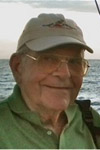 |
|
Frederick Mills
|
Frederick Mills, a physicist who worked at Fermilab when the lab was beginning to build the Tevatron, passed away in Tucson, Ariz,. on June 21. A pioneer in the area of proton synchrotron technology and a fellow of the American Physical Society, Fred worked at Fermilab from 1973 until 1992. His 19 years of work at the laboratory are to this day highly regarded in the field of accelerator physics.
Fred was one of a small group of innovators who proposed to use Fermilab's Main Ring accelerator for very-high-energy proton-antiproton collisions. The Main Ring had accelerated protons towards a fixed target in earlier experiments, but Fred and others saw that, provided a suitable antiproton source could be developed, the Main Ring could be used to collide two moving beams, increasing the collisions' energies.
However, because the Tevatron offered greater long-term opportunities for colliding beams, Fermilab initiated an R&D program on antiproton collection and electron cooling with the goal of preparing the Tevatron for proton-antiproton collisions, even though the Tevatron was stretching its resources to the limit. Over the next several years, Fred, Jim Griffin, Peter McIntyre and Don Young led the team that designed and built a small 200-MeV proton storage ring and a 110-keV electron cooling system. Fred helped bring about a collaboration between Fermilab and Novosibirsk, which had developed electron cooling and lithium lenses, and helped Fermilab incorporate these techniques into its plans. Argonne and Lawrence Berkeley laboratories built beam diagnostics and prototype multi-gigahertz stochastic cooling systems for the cooling ring. Cooling experiments in the 200-MeV ring provided this collaboration with their first opportunity to test prototypes of these innovative cooling systems.
Read more
—John Peoples, Sergei Nagaitsev and Steve Holmes
|
European countries to join in building particle accelerator in Russia
From UPI, Aug. 8, 2013
MOSCOW, Aug. 8 (UPI) — Germany, Bulgaria and three former Soviet republics say they have agreed to help Russia construct a heavy-ion collider in a Moscow suburb.
The parties signed a letter of intent Thursday to cooperate on building the collider, planned for 2017, on the premises of the already existing Nuclotron particle accelerator in the town of Dubna, RIA Novosti reported.
The collider is intended to accelerate and collide protons and relatively heavy ions such as gold to study a recently discovered phase of matter, a plasma of fundamental particles quarks and gluons, officials said.
Read more |
|
Spotlight studies the proton’s glue
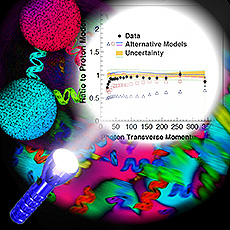 |
Photons, the particles of light, make excellent probes of the strong-force interactions that hold the proton together.
|
The strong force is difficult to study because gluons, the carriers of the strong force, interact with each other. This makes the inside of a proton a very busy place, since the gluons that the constituent quarks (two up and one down) exchange to bind together interact in complicated ways. On the other hand, photons, which are the particles of light and carry the electromagnetic force, do not interact with each other or with gluons. This makes the photons that are produced directly out of proton collisions excellent probes of the strong force and helps physicists test models of the complex interactions that hold a proton together. A recent analysis at DZero sheds new light on proton structure by looking at events with a photon and a quark or gluon.
Finding the “right” photons was the major challenge in this analysis. When quarks and gluons are made in a collision, strong-force interactions make them almost immediately develop into a spray of particles called a jet. To get the most information about the proton’s structure, analyzers focused on photons that were made directly during the collision and not as part of the formation of a jet. A special discriminant was built based on detector information that could help select direct photons and reject the background from jets. The shape of the discriminant output allowed the analyzers to determine how pure their sample of photons was from background contamination in each region studied.
In most of the regions tested, the analyzers found good agreement between the observed data and the predictions made with various models. However, in some regions the data showed trends that did not match any prediction. The new observations, which have precision on par with many of the predictions, will be useful for improving models of the proton and gaining an even deeper understanding of the strong force.
—Mike Cooke
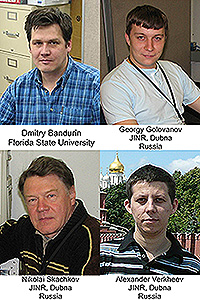 |
These physicists made major contributions to this analysis.
|
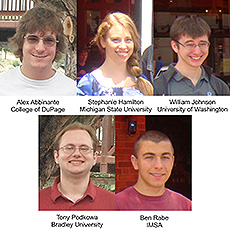 |
Internships at Fermilab give undergraduates the opportunity to learn about high-energy physics while contributing to ongoing research. These undergraduate students spent their summer at DZero, where they made significant contributions to ongoing studies of the Higgs boson.
|
|
Flash mob
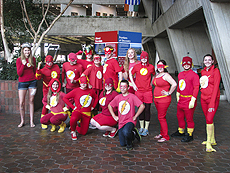 |
Local participants in GISHWHES, an international charity scavenger hunt, joined Fermilab's public tour on Wednesday. Their mission: to snap a photo of themselves dressed as DC Comics' The Flash while standing in (or near) an operational particle accelerator. Scavenger hunters snapped photos inside the Linac gallery and drew smiles and laughs from passing employees. Photo: Andre Salles, DO |
|
Dark energy could be the offspring of the Higgs boson
From New Scientist, Aug. 14, 2013
The particle credited with giving others mass, the Higgs boson, may also be to blame for the universe flying apart ever faster. That's because the Higgs boson could, in principle, be giving rise to dark energy.
Read more |
|